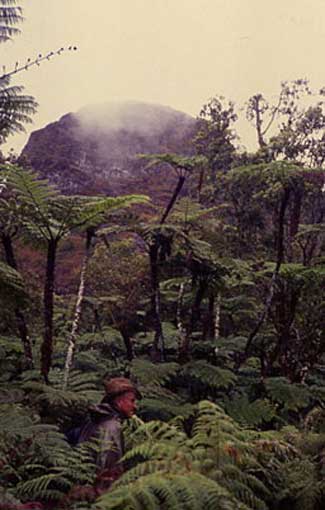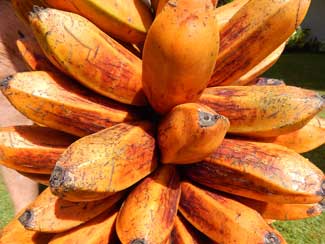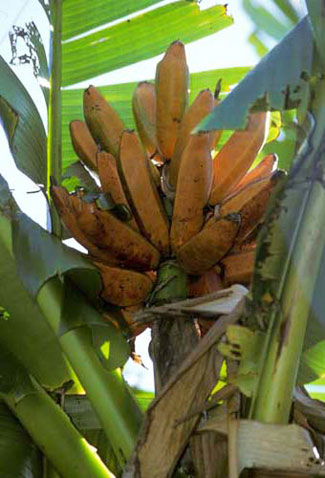The "ancient Sage" mentioned in one of Edward Lear's rhymes may well have been contemplating the origin and initial meaning of this word after reading Jean Kennedy's "Pacific bananas", the notes on the origins of traditional varieties grown in Polynesia in Art Whistler's Plants of the Canoe People, and the other works looking at the whakapapa and distribution of bananas in Polynesia before the arrival of Captain Cook:
... A hill there is, a little to the north
And to its purpledicular top a narrow way leads forth; --
And there among the rugged rocks abides an ancient Sage, --
An earnest man, who reads all day a most perplexing page.
Although the proto-word *feki has been reconstructed from apparently cognate terms in several Eastern Polynesian languages, both the precise form and original meaning of the source word are likewise difficult to ascertain with confidence. The modern Māori word has a long final vowel, both vowels in the Tahitian word are long, and Marquesan and Rarotongan words are both recorded with short vowels. To complicate matters further, although the Rarotongan form was noted in connection with two species of tree fern by the botanist Thomas Cheeseman in 1903, and also in relation to the cooked pith as a source of famine food by Te Rangihiroa in 1944 (p.17), Arthur Whistler in 1990 could not find any evidence of its current use; it is not mentioned in either the Savage or Buse dictionaries, nor is it listed for Rarotonga in the Cook Islands Natural Biodiversity database (although there is a cognate word adopted from Tahitian, vē'ī, used in Aitutaki for the fehi banana).
Although the Hawaiian and Tahitian words are cognate, the Hawaiian form probably was not directly inherited from the proto-language. It was most likely introduced from Tahiti in the late eighteenth or early nineteenth century, along with the papaya and the starchy cooking banana Musa troglodytarum to which it refers. However, the Pollex database also lists it as a name for the tree fern Cibotium menziesii, generally known as hapu'u 'i'i, or 'i'i'i (on account of its brownish fronds), and a distant botanical relative of the New Zealand whekï. There are no corresponding entries in either the Pukui or Andrews dictionaries, or in the Palmer monograph on Hawaiian ferns. However, if this an old Hawaiian word for a species of tree fern, then quite possibly that sense may indeed have been inherited from an earlier stage of the language.
 The Pollex database gives "A tree fern" as the probable original referent; however, on the basis of the known apparent cognate forms, I would guess that this may originally have been a rather vague term for slender, frond-bearing tree-sized plants. That doesn't solve the mystery of the differences in vowel length, but it may well have been that the word was a rather recent coinage at the time of its dispersal, with that detail not yet settled! David Malo noted that the bases of the fronds of certain species of tree fern were cooked and eaten as famine foods in Hawaii, so the applications of the name to a variety of kūmara in Hawaii would fit in with both the banana and tree-fern word origins. The Pollex database gives "A tree fern" as the probable original referent; however, on the basis of the known apparent cognate forms, I would guess that this may originally have been a rather vague term for slender, frond-bearing tree-sized plants. That doesn't solve the mystery of the differences in vowel length, but it may well have been that the word was a rather recent coinage at the time of its dispersal, with that detail not yet settled! David Malo noted that the bases of the fronds of certain species of tree fern were cooked and eaten as famine foods in Hawaii, so the applications of the name to a variety of kūmara in Hawaii would fit in with both the banana and tree-fern word origins.
There is some information about the Cibotium ferns (Hawai'i) on the page for Hapu'u, and about the Whekī (Dicksonia squarrosa, Aotearoa) on the linked page. The Cook Island 'eki, Alsophila tahitensis, A. decurrens and Sphaeropteris parksiae are mentioned on the page for Proto-Polynesian *Ponga; all three are also known collectively as Panga.
Two species of tree fern are known as Heki in the Marquesas: Sphaeropteris medullaris and S. feani. The Marquesan plants of S. medulalris are generally much shorter than their counterparts in Aotearoa, although they do share the drooping fronds. The Marquesan "trees" are sometimes only a foot tall, and rarely more than 3 metres. The stipes are also smooth or only slightly rough, and black only at the base, otherwise green. Lorence and Wagner in their Flora note that "further study of this species complex throughout its range [southern New Ireland to Fiji and Polynesia, except Hawai'i] is necessary to determine if more than one species should be recognized" (p. 112). Sphaeropteris feani is endemic to the Marquesas, and is also only small to medium-sized (with a trunk from 30 cm to 3 m before the fronds). It has very scaly stipes covered with pale silvery-brown scales. This tree fern has just a few fronds (about 4 to 6 at a time) forming a rosette, with the stipes 30 to 90 cm long and the blade about 80 to 130 cm long x 50 to 100 cm wide. Sphaeropteris feani lives in wet shrub lands and low cloud forests (to about 1000 m) on ridges and slopes.
This leaves Musa troglodytarum, the fehi banana or mountain plantain. This plantain banana appears to have originated in Northern New Guinea and Bismarck Archepelago from hybrids among several different species and clones -- the precise genetic origin is still uncertain. Some strains seem to have reached Micronesia and Samoa very early in the Polynesian settlement era via Vanuatu, and another seems to have been taken via the Solomons to Eastern Polynesia about a thousand years ago, initially to the Marquesas and Tahiti and later to the Cook Islands and (possibly in the late eighteenth century) to Hawai'i. This is the Tahitian Fē'ī. Another, quite distinct fertile variety which has the status of a separate species, Musa fehi, ended up in New Caledonia. It is thought that cultivated bananas may first have been developed from shoots of seedlings of the New Guinea species Musa maclayi found to have good fruit, growing around banyan trees and clear patches in the forest where the seeds were dropped by hornbills. The hornbills have a great liking for these fruits, and are key agents in propagating the plants. Since the New Guinea area was first settled by people over 40,000 years ago, there was plenty of time for local people to develop a suite of local varieties before the Austronesians arrived on the scene to carry some of them as far as Polynesia.
The forebears of the current Polynesian varieties were probably carried to their new destinations as rooted shoots, as most varieties have few, if any, viable seeds. Furthermore it is difficult to grow these varieties from seed, the resulting plants may not turn out to have the desirable qualities of their parent, and in any case it would take at least two years for a carefully nursed seeding to bear any fruit.
 Fē'ī are high island plants, and do not generally do well on attols. In Tahiti they were a very important food source originally planted extensively in valleys at higher altitudes (above 500 metres), but they are now grown extensively in lowland areas. They are characterized by their erect fruit bunches, purplish sap, black trunks, orange-coloured fruit with bright yellow pulp, and stout, stubby appearance in contrast to the commercial Cavendish bananas. (The distinction between bananas and plaintains is somewhat arbitrary; all are members of the banana family (Musaceae), but plantains are generally best cooked -- even when fully ripe they are somewhat astringent to the taste, whereas other bananas are good to eat raw when ripe. They have considerable nutritive value and are a particularly good source of Vitamin A. Fē'ī are high island plants, and do not generally do well on attols. In Tahiti they were a very important food source originally planted extensively in valleys at higher altitudes (above 500 metres), but they are now grown extensively in lowland areas. They are characterized by their erect fruit bunches, purplish sap, black trunks, orange-coloured fruit with bright yellow pulp, and stout, stubby appearance in contrast to the commercial Cavendish bananas. (The distinction between bananas and plaintains is somewhat arbitrary; all are members of the banana family (Musaceae), but plantains are generally best cooked -- even when fully ripe they are somewhat astringent to the taste, whereas other bananas are good to eat raw when ripe. They have considerable nutritive value and are a particularly good source of Vitamin A.
In Rarotonga these plants are known as 'ūtū (a contraction of the older form 'uatū (Proto Central Eastern Polynesian *huatū "fruit standing erect"), a good descriptive term for the appearance of the fruiting bunch. This is paralleled in Mangareva ('uatu) and the Marquesas (huetu). In Aitutaki however the mountain plantain is known as ve'i, a later adoption from Tahitian rather than directly inherited (the Tahitian glottal stop would be "k" in Aitutaki if the words were from the same Polynesian source).
 In Rarotonga the fruits of Musa troglodytarum are often made into a pudding known as poke, by baking the pith mixed with fruit and/or vegetables and coconut cream. In Hawai'i, where the plant is generally known as polapola (from Bora Bora, in Tahiti), Isabella Abbott notes that these fruit were baked in an umu then pounded to make poi mai'a (banana poi). In Samoa, Tahiti and Rarotonga the dark outer skin of the "trunk" may be used to plait hats or mats, or in strips for decorating baskets, mats and fans. This was also the case in Hawai'i: Wagner et al in their Manual (p. 1466) note that: In Rarotonga the fruits of Musa troglodytarum are often made into a pudding known as poke, by baking the pith mixed with fruit and/or vegetables and coconut cream. In Hawai'i, where the plant is generally known as polapola (from Bora Bora, in Tahiti), Isabella Abbott notes that these fruit were baked in an umu then pounded to make poi mai'a (banana poi). In Samoa, Tahiti and Rarotonga the dark outer skin of the "trunk" may be used to plait hats or mats, or in strips for decorating baskets, mats and fans. This was also the case in Hawai'i: Wagner et al in their Manual (p. 1466) note that:
The mai'a hē'ī [hē'ī banana] was introduced to Hawai'i in fairly recent times, probably from Tahiti, where they are an important starch food crop with many named varieties. They are rarely cultivated, but allowed to grow wild in moist interior valleys were they are occasionally harvested. They are cooked when mature, but not yet soft, and the black surface of the lower pseudo-stem was formerly used in weaving with hala [pandanus] to achieve dramatic patterns.
In Tahiti the trunks are also occasionally used for making rafts for crossing streams or lakes. The sap is used to make a black dye in Rarotonga, and also medicinally in treating shingles. In Samoa the sap collected from a cut made in the trunk was formerly used for making a purple or greyish dye for siapo (tapa), but this is now rarely done.
The papaya (Carica papaya, Caricaceae) was also given the name hē'ī in Hawai'i, probably because of its banana-like habit of growth and its orange-yellow fruit. It arrived in Hawai'i about the same time as the fehi banana, and had become naturalized in the 1880s. Also in Hawai'i, the name hē'ī was given to a variety of kumara. The entry in the Pukui and Elbert dictionary says simply "A variety of sweet potato usually called 'uala hē'ī"; this may be a more recently developed or introduced variety with similar qualities to the hē'ī banana (mai'a hē'ī); unfortunately it is not listed among the varieties studied by Elizabeth Winnicki and associates ("Characterizing the diversity of Hawai'i sweet potatoes", 2021).
A NOTE ON TAXONOMY OF TREE FERN SPECIES. A few months after this page was revised in 2022, and shortly after Te Māra Reo Kawerongo #3 was sent out, a decision was made that the NZPCN database should adopt a revised taxonomy for these plants following the publication of several comprehensive DNA and taxonomic studies overseas. The New Zealand tree ferns formerly placed under Cyathea were reassigned to the re-established genera Sphaeropteris (C. medullaris) and Alsophila (all the rest -- with the former C. dealbata being re-named A. tricolor).
The main additional consequential changes required for this web site are: Cyathea parksiae becomes Sphaeropteris parksiae; Cyathea truncata a.k.a. Alsophila truncata becomes Sphaeropteris truncata; Alsophila rugosula is merged with and replaced by Sphaeropteris lunulata; Cyathea decurrens becomes Alsophila decurrens; Cyathea affinis becomes Alsophila tahitensis; also Angiopteris commutata becomes Angiopteris evecta. The genus Cibotium is shifted from the Dixoniaceae to a separate family, Cibotiaceae. These botanical name changes will be made page by page as time permits.
The reasons for these changes are outlined in Kawerongo #3 and #4. It should also be noted that these changes are not universally regarded as necessary. If you search for the generic name Alsophila on the Atlas of Living Australia website, for example, you will get this message:
genus: Alsophila R.Br. (accepted name: Cyathea)
Similarly, the botanists at Te Papa Tongarewa (Museum of New Zealand) prefer to regard Cyathea as a single genus, with Alsophila, Sphaeropteris and Cyathea s.s. as subgenera or divisions of the larger grouping.
|

